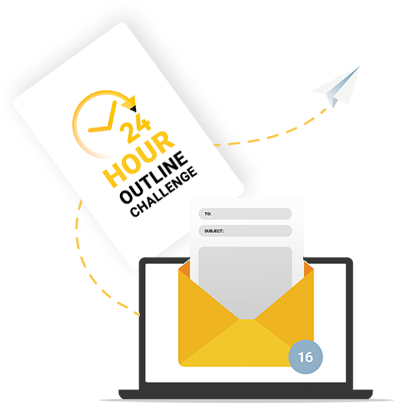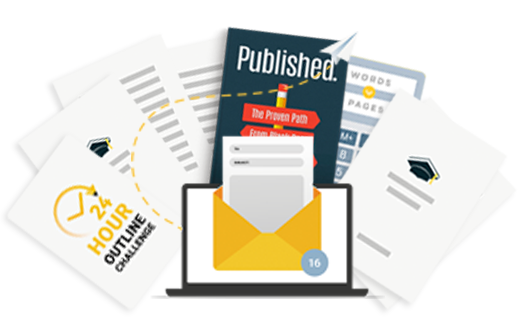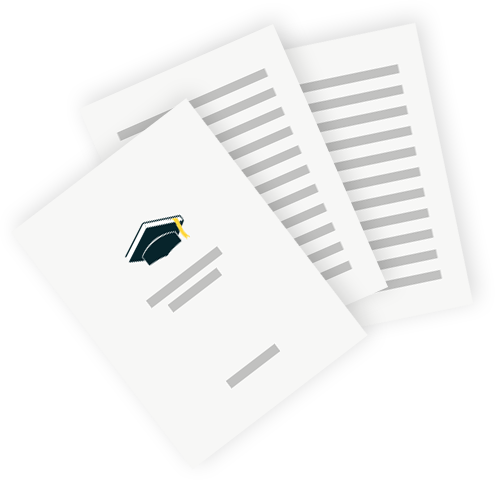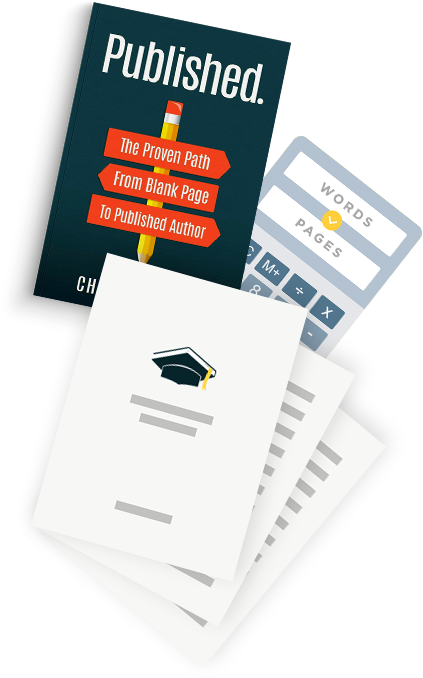If you’ve considered being a professional author, one of the biggest questions you’re likely asking is: How much money can I make with this?
And that’s a fantastic question! Many factors go into how much an author can make off of their books. The biggest component of regular author checks are royalty payments.
But what are book royalties? How are they determined? How can we make more with royalties? Do authors make higher royalties by traditionally publishing, hybrid-publishing, or self-publishing their books?
How do book royalties work?
The term “book royalty” refers to the cut of sales that an author receives from their book. The royalty percentage an author receives can depend on the book’s format, publication type, platforms, and other variables.
Since I obviously have the most accurate royalty earnings information for my own books, let’s look at examples of the royalty rate for my book, Little Birds. We’ll look at the ebook, paperback, and hardback earnings. Little Birds was self-published through Amazon’s KDP.
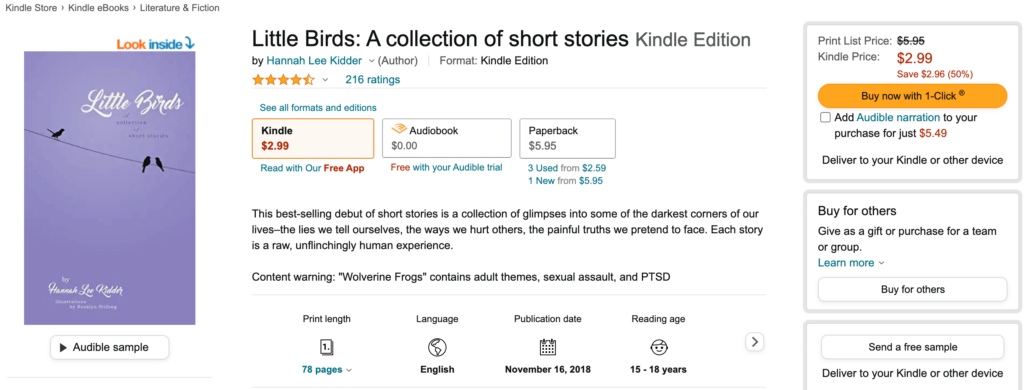
My listed prices are pretty standard for the industry and genre, so these numbers are pretty widely applicable for royalty rate estimations.
Paperback royalties
The Little Birds paperback is currently listed for $5.95, with a 60% royalty rate. The printing cost is $2.15, which makes my earnings per paperback sold $1.42.
Ebook royalties
The Little Birds ebook is currently listed for $2.99, with a 70% royalty rate. Since eBooks don’t have printing costs, that means my earning per eBook sold is $2.04.
Hardback royalties
Because of the book’s length, it didn’t make sense for me to offer a hardback version of Little Birds, but I’ve calculated the royalty rate I would potentially get if I produced a hardback through the popular self-publishing platform, IngramSpark. IngramSpark allows you to tweak things like the discount rate for wholesales, which means the royalty rate can vary by a pretty wide margin depending on what the author selects.
If I printed hardback versions of Little Birds through IngramSpark and sold them for $14.99 with a 30% wholesale discount and a print charge of $4.67, my payout per copy sold should be $5.82.
As you can see, the best royalty rate is with eBooks, but the highest actual payout is hardback. Readers have preferences between formats, and many readers will “try out” a book in a digital format before they decide to invest a little more in owning a physical copy. Because of consumer trends and preferences, the most profitable option for authors is to offer their book in as many formats as possible to increase their overall payout. This includes ebooks, audiobooks, paperbacks and hardbacks.
Calculating author earnings using book royalties
So how much might an author earn annually through their book royalties? Like we’ve mentioned, there are many factors that affect the payments authors receive. But let’s see how accurate we can get at guessing. This information might be helpful for you in deciding whether you want to pursue self publishing or traditional publishing in the future, and it might influence the decisions you make down the road regardless of which route you take.
Self-published author earnings through book royalties
The obvious formula for determining the annual royalty income of a book is using the formulas above for the format of the book, then multiplying by the number of copies sold.
Doing that calculation for every format of every book available for sale, then summing them all up will give you the self-published author’s earnings through book royalties.
Self-published authors usually earn between 60-80% royalty rates. Click here on the image below to go to a page where you can calculate your royalties directly.
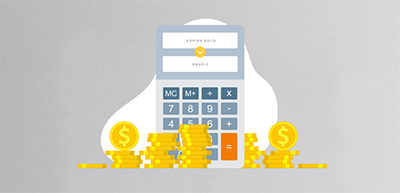
Traditionally published author earnings through book royalties
It’s a bit trickier to determine a traditionally published author’s royalty income, because they don’t start earning right away. In fact, most of the time, traditionally published authors won’t actually earn any royalties from their book sales at all.
A traditionally published author typically receives an advanced payment from the publisher. This can be anywhere in a wide range of amounts, from $5,000 to millions. The less established the author, the smaller the advance. The nicher the subject often lowers the advance as well. More established writers with bigger audiences and more marketable genres can expect the highest advance payments for their books.
These payments are also usually paid out in small amounts over a long period of time (and in recent years, these increments have gotten smaller, resulting in authors not getting their full advance payment for multiple years). This means that not only are traditionally published authors relying on a set amount of money instead of consistent royalties (which we’ll get into in a second), but it also means they’re receiving that money in smaller amounts, which results in the value of that money actually being much lower. Authors are getting paid less and less, while publishers are making more money off of them.
Traditionally published authors don’t begin receiving royalty payments until they’ve “earned out” their advance. That means the book has to sell enough copies to earn back the money the author has already been given. If they’ve reached that threshold (most books never do), the author may begin receiving royalty payments.
Traditionally published authors usually earn between 7-30% royalty rates, only after their sales have “earned out” the book’s advance, which, again, never happens for many, if not most, authors.
What are typical book royalties?
Let’s look at some specific royalty rates for different publishing options and formats.
Traditionally published books
Hardback: Under standard royalties, a traditionally published author should receive 10-30% for sales of hardbacks.
Paperback: Under standard royalties, a traditionally published author should receive 10-15% for sales of paperbacks.
eBook: Under standard royalties, a traditionally published author should receive 10-25% for sales of eBooks.
NOTE: Traditionally published authors typically don’t begin receiving those royalty payments until AFTER their advanced payment has been “earned out.” And remember, that amount of money might take a while to roll in as publishers cut authors’ advanced payments into smaller and smaller portions for the publisher’s own benefit.
Self-published books
Self-published authors not only receive higher royalty rates, but they also begin earning royalties immediately upon their first sale. This gives self-published authors more financial stability after the release of their book, and it means they see a more direct profit from the books they sell. The royalty rate will depend on their method of self-publishing. Let’s break down the different methods of self-publishing and their royalty rates.
Hardback: Under standard royalties, a self-published author should receive 60-100% for sales of hardbacks.
Paperback: Under standard royalties, a self-published author should receive 60-100% for sales of paperbacks.
eBook: Under standard royalties, a self-published author should receive 70-100% for sales of eBooks.
Hybrid-published books
Hybrid publishing combines traditional and self-publishing styles. Hybrid-published authors pay hybrid publishing companies to produce and sell their book for them, which will include things like editing and cover design. The benefit over self-publishing is less time investment, and the benefit over traditional publishing is more control of the process and turnaround time, as well as higher royalty rates. Hybrid-publisher royalty rates depends on their contract with the publisher, but here’s the range you can expect depending on the method of sale:
Hardback: Under standard royalties, a hybrid-published author should receive 20-100% for sales of hardbacks.
Paperback: Under standard royalties, a hybrid-published author should receive 20-100% for sales of paperbacks.
eBook: Under standard royalties, a hybrid-published author should receive 20-100% for sales of eBooks.
How long do book royalties last?
Now that we’ve gone over how royalties work out based on the different methods of publishing, let’s talk about how book royalties work long-term. After all, if you want to write full-time, you’re probably going to want to be thinking about your book sales well beyond your release year. Once an author starts earning royalties, do they earn them forever, or is there a cut-off date?
- Related: Interview with Full-Time Nonfiction Career Author
- Related: Interview with Full-Time Fiction Career Author
Traditional publishing
Traditional publishers will calculate and pay out their royalty dues every six months, though the fixed schedule can vary from publisher to publisher.
As for how long an author receives royalty payments after they begin receiving them (after they’ve earned out their advance), it will depend on the contract.
An additional thing to keep in mind with traditional publishing is that authors often have the option to “pay back” their advance in order to receive higher royalty rates and make “new” money. This can be a risk, because there’s no guarantee that they’ll earn enough royalties to re-earn the payment they gave back to the publisher, much less to start earning more money afterward.
Self-publishing
Through self-publishing, authors should expect to receive royalty payouts once a month, provided they’ve earned enough that month for their specific platform to make the payment transfer. There’s typically a staggered pay schedule, but once you’ve hit the stagger, you should receive a payment each month.
For example, I published Starlight in October 2020, but I didn’t begin receiving payments from those sales until January 2021. In February 2021, I received payment for the sales I made in November 2021. But every month since, I’ve received a check for sales, even though those sales were actually earned a few months before.
Royalties through self-publishing will pay for forever, or however long your book is listed for sale. You’re making money off every book sold, so as long as people are still buying your books, you will still be getting a cut from those sales.
Typically, a book will sell most of the copies it ever will within the first two years of publication. This is why authors and publishers often republish books, either as compilation pieces, new editions, cover updates, and other things that can give the book a fresh spin for a new market and a new release, giving it another two years of new life. Self-publishing gives authors a lot of freedom to publish multiple and updated versions of their books to boost sales, whereas with traditional publishing, the publisher makes that call on if its worth it for them to update a book or make a marketing effort.
Hybrid-publishing
Like traditional publishing, the amount of royalties and the frequency of those payments will depend on your contract with the publisher. Hybrid-publishing doesn’t offer an advance, like traditional publishing does (in fact, they charge you an initial fee for publication), but they do offer much higher royalty rates.
Royalty earnings can vary greatly across publishing method, book format, and sales venue. The best way to decide which publishing is best for you is to consider payment along with time investment, effort and knowledge required, and your own personal goals for yourself and your writing career.
It’s hard to nail a firm number about how much an author will earn, because that depends entirely upon the author and how they choose to publish their books. Marketing, especially in the leadup to a book launch, can make the world of difference when it comes to payouts for self-published and traditionally published authors alike.
But now that you know how it works for both parties, which route do you think is best for you?
